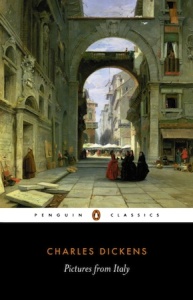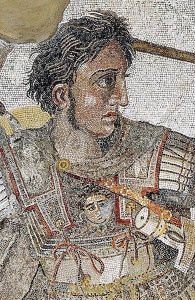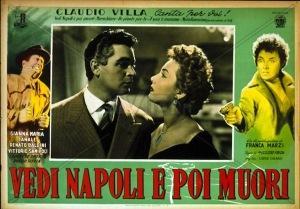Where unhappiness ends: Naples beyond Ferrante
by Mika Provata-CarloneYou know you are in Naples when the taxi taking you to the city centre from the tiny local airport seems to be driven by a perfectly amiable madman, dead set on breaking your neck (and his) as he hurtle-bumps his vehicle down the almost vertical, serpentine ribbons that are many of the city streets. As you count the dents and scrapes on the cars taking part in this unearthly, Steve McQueen-like race on the cobbled surfaces, the reality of your predicament becomes frightfully palpable. You begin to doubt whether you made it to your hotel alive when, in an almost apocalyptically blinding light, you enter a monumental lobby and the concierge tells you, with perfect nonchalance, “Buongiorno, Signora, mi chiamo Ferrante.”
Conjured visions, associations or images of Naples don’t always bring to mind breathtaking beauty or an earthly paradise, at least not immediately, not today, for all that Goethe sang the city’s praises, immortalising the famous adage “see Naples and die”. Naples for many is the inevitable thorn in a trip to see Pompeii, Paestum, Herculaneum, the Amalfi coast, Capri and the villas of glorious or inglorious emperors and of famous or infamous socialites. Judiciously lodged in Positano, Sorrento or the rather impossibly mythical Hotel San Pietro, one must alas brace oneself to face the city, if only for the sake of its archaeological museum, so as to stand in front of the many frescoes, vases, statues, objects ringing with the echoes of the past. One feels almost as heroic, for having picked up the courage to get there, as Alexander facing Darius in the battle of Issus, now staring down at you regally, approvingly from the Alexander Mosaic.
Elena Ferrante (who could be related, or perhaps not, to our young concierge) has inevitably enhanced this image of the city as a place of dark, shatteringly poignant human tragedy, what Walter Benjamin called the city’s “rich barbarism”, even as she has written with the greatest feeling about the infinite humanity even of its most troubling, blackest aspects. Neapolitans are proud of their Ferrante – and yet they would rather discuss her anonymity, the polysemy of her mysterious identity, rather than her books, her Naples and her Neapolitans. Reader beware, do not go further…
For Walter Benjamin, Naples is the city of an idealised chaos of potentiality – where being porous like the tuffo, the volcanic stone of its buildings, ancient and modern, is a way out of impasses.”
However, there was, and still very much is, another side to Naples: a deeply noble, grand, rich side, full of unmistakable tenacity, swooning stories, unfathomed cultural treasures and the dream of a changed world-image before it is too late. Naples, Benjamin would write, in what is perhaps the most poetic and shrewdest portrait of the city, is supreme thanks to its Porosität, its porousness, the flux of its elements, its history and people, the permeation of the place and its soul by the past, present and future of an infinite number of cultures, languages, life gestures and influences. For Benjamin, Naples is the city of an idealised chaos of potentiality – where being porous like the tuffo, the volcanic stone of its buildings, ancient and modern, is a way out of impasses, an answer to any material or philosophical aporia.
Naples, the New City of the Greeks, is beguilingly old: the first Greek colony was founded in around 600 BC by Euboian settlers. From the very beginning, myth and reality were the flesh and blood of the city and its destiny. Names like Parthenope, the name of a siren spurned by Odysseus along his travels back home, become local signifiers, markers of a very particular identity, local character and sense of being. Another name, now Possilipo, could be that dream of the future that has sustained the people of Naples through Vesuvian eruptions, successive overlords, massive WWII bombings and almost unending economic polarity and tension. The original Pausilypon was the name given to the villa of Augustus’ friend Publius Vedius Pollio, standing between Naples and Puteoli, and a place that would have hosted Virgil, Horace, Augustus and many others. It means “that which stops sadness and unhappiness”, a kind of locus amoenus that was a palliative to the pains of urban Roman life.
For the Romans, Naples was that pleasant place where woes were forgotten thanks to distance or pleasure, where dark plots were hatched, steely alliances were forged, health was restored, spells and potions were concocted and art and literature reigned supreme, to counterbalance commerce of every imaginable kind. Statius, Gaius Lucillius, Virgil, Epicurus, Horace, Varius Rufus, Philodemus of Gadara, Quintilius Varus, all claimed Campania as their very own Arcadia. The Pan of that Arcadia was Maecenas, rich, refined, all-powerful, with an unmistakable flair for the beautiful and the monumentally everlasting. As one walks down the streets of Pompeii or Herculaneum, or through the sturdy columns of the Doric temples of Paestum, down the tiny whitewashed streets of the miniature towns sprinkled on the slopes of the Amalfi coast, it is impossible not to feel a thrill on one’s skin, a tingling alert to all the ghosts still fluttering impatiently, eternally nearby. The throngs of tourists somehow confirm that very real illusion – the inward eye gains the upper hand and you are just there, in the midst of the timeless marketplace, bumped and squabbled, enthralled and transported.
A medieval legend has it that Virgil placed a magic egg into the foundations of the Castel dell’Ovo with the spell that were the egg ever to break, Naples would be doomed… it seems his egg must still be there uncracked.”
The past never stopped for Naples – it is only a very naïve assumption of our internationalism that what cannot be seen is therefore not there. Naples very specifically thrived and prospered in the Duocento and the Quatrocento, was a centre for Humanism and the Enlightenment, for the Italian Renaissance and for a very particular type of Neoclassicism – the Bourbon style. A medieval legend has it that Virgil placed a magic egg into the foundations of the Castel dell’Ovo with the spell that were the egg ever to break, Naples would be doomed. To the Neapolitans and other Italians of the Middle Ages, Virgil was an inscrutable sorcerer, soothsayer, dreaded and longed-for magician, and it seems his egg must still be there uncracked, for Naples is still very much a place of extraordinary beauty, enchantment and as yet unexhausted promise.
Gianbattista Vico, Torquato Tasso, Thomas Aquinas, Boccaccio, Giordano Bruno and Benedetto Croce are all branches of the Neapolitan tree, as are the rather indulging Sybarites, from further down south. Giacommo Leopardi, now buried next to Virgil’s ‘tomb’, is only one of the many writers, Italian or foreign, who roamed its streets in search of inspiration, or release from it. Naples throughout the ages was famous for its political power over the Italian map and for the distinctive influence of its literary salons. From the topical uniqueness of its dialect and the canzoni, the Pulcinella, the opera buffa and the cafés chantants, to the deeply hued spectrum of its theatres, dramatists and actors, its filmmakers and figures of popular culture, such as the rather darkly quirky nobleman, Antonio de Curtis, otherwise known as Totò, Naples throbs with many heartbeats, whether gilded like the walls of the Caserta or the Capodimonte, or unforgettably evocative, stirringly human, like the voice of Massimo Troisi. There is the Naples of the Futurists and the Surrealists, radical, tame or outright fascist on occasion, the landscape of The Decameron as depicted by Pier Paolo Pasolini, who called Naples “the nation in the guts of a nation”, the social tapestries of de Sica’s Ieri, Oggi, Domani or Matrimonio all’Italiana, certainly the curves, pouts, piercing eyes and ripostes of the unrepentantly Neapolitan Sophia Loren.
Above all, Naples is eternally elusive, impossible to pin down as one, as the same, as part of simply anything. It is a city constantly midway upon the journey of life and Dante too is there, presiding pensively over his very own square. To walk through the streets is a journey through time but also a journey that somehow manages to combine peace and equanimity with inconceivable commotion and bustle. Everywhere you go, you are on someone else’s trail, from Goethe to Stendhal, Henry James to Dickens and George Gissing, Shelley, most probably, Caravaggio almost certainly. Ralph Waldo Emerson wrote that “Travelling is a fool’s paradise… At home I dream that at Naples, at Rome, I can be intoxicated with beauty, and lose my sadness… At last [I] wake up in Naples, and there beside me is the stern fact, the sad self, unrelenting, identical, that I fled from… My giant goes with me wherever I go.” Leave the giant at home, if you can, and see the children trotting off to school in the morning in their pinafores, sfogliattela or bigne in hand, look at the light rays sneaking through tight alleys that can only be negotiated in single file, imagine the tribes and nations that walked the same steps: a shocked, flamboyant Dickens? A ruminating Stendhal? A philosophical Benjamin? A disapproving Madame de Staël? A love-struck Boccaccio? A hyperbolic Compton MacKenzie? Certainly a happily employed Alexandre Dumas père, busy not only with the writing of The Count of Monte Cristo and The Three Musketeers, but also as an ardent Garibaldist, Neapolitan historian and Director of Antiquities at the National Archaeological Museum. Every wall is a story in the historic centre, but also beyond it, where flaking paint, sparkling laundry, amassed flowerpots and glisteningly tanned figures leaning over precariously delicate railings tell you of a different cycle of legend and lore.
Jean-Jacques Rousseau saw this too. In La Nouvelle Héloise he notes: “nowhere else are life and death placed in such harsh and close opposition.” Dickens would make both darkness and light of this titanic clash, claiming that the violent convergence of attraction and depravity in Naples requires a new literary style to capture it and do it justice, a “new picturesque” of unprecedented rawness but also beauty. For Neapolitans, tragedy and comedy, the foul and the fair walk hand in hand, as do pain and joy, the small and the tremendous. So much so, they even have their very own Archias figure in King René of Anjou, who ordered that business wait another day, or until he had finished painting a picture of a partridge, after his son had just lost the Kingdom of Naples. To know Naples truly is a knowledge as complete, as “lofty” according to Goethe, as intoxicating, as it is terrible and electrifying. Molière’s The Miser contains the cryptic utterance: “Vous parlez devant un homme à qui tout Naples est connu” – “you speak before a man to whom all Naples is known.”
Neapolitans sigh when you ask them if their city is safe: they love it, no, they adore it, and they want you to fall in love with it desperately and passionately as well.”
Three thousand years of continuous history do not come cheap – yet they come with spectacular treasures. The historic centre of Naples is apparently the largest in Europe, and it is worth every step to walk within its girth. Husky or dodgy characters from Ferrante’s pages as well as light-hearted companions from more complacent, idyllic romances will shadow you or accost you, greet you, or unexpectedly, munificently help you. Neapolitans sigh when you ask them if their city is safe: they love it, no, they adore it, and they want you to fall in love with it desperately and passionately as well. Common sense, they will say, is all that’s needed – è normale, no? Naples was the first Italian city to rise against Nazi presence on the national soil, and that too is a proud part of the urban legend, its scugnizzi as heroic as any street-urchin after the manner of Victor Hugo’s Gavroche. Above and below street level, Naples expands and spreads its secrets, dark and irresistible. Tunnels, caverns, quarries for the precious tuffo, catacombs and clandestine passageways; all will tell a story. Our hotel car park was a monumental, porous cavern, almost sublime in its magnificence and haunting menace. Ghosts will speak – this was a prison for political dissidents while the Nazis held the reins.
 Ferrante is a grand voice for Naples, a mystical summons to the place. Yet she is only one of a contrapuntal polyphony that will not keep silent: from Boccaccio and his Elegy of the Lady Fiammetta, the first psychological novel, it is claimed, of Western literature, to Giovan Battista Marino, Giambattista Basile and Francesco de Sanctis, to Ferrante’s near or perfect contemporaries such as Maurizio da Giovanni, Anna Maria Ortese, Patrizia Rinaldi, Antonella Ossorio or Roberto Saviano, Naples will speak. Many others will also do so for her or about her, from John Webster’s The Duchess of Malfi, to Goethe’s Italian Journey, Dickens’ Pictures from Italy, to Henry James’ Italian Hours. Or George Gissing’s By the Ionian Sea: Notes of a Rumble in Southern Italy, and the piquant Extraordinary Women and Vestal Fire of Compton MacKenzie (he of The Monarch of the Glen and Whisky Galore). Then on to Shirley Hazzard’s The Bay at Noon, The Ancient Shore: Dispatches from Naples and Greene on Capri: a Memoir. Margaret Drabble provides The Seven Sisters, and Susan Sontag too adds The Volcano Lover to the long pageant of words, stories, traumas, myths that will penetrate and permeate those Neapolitan pores.
Ferrante is a grand voice for Naples, a mystical summons to the place. Yet she is only one of a contrapuntal polyphony that will not keep silent: from Boccaccio and his Elegy of the Lady Fiammetta, the first psychological novel, it is claimed, of Western literature, to Giovan Battista Marino, Giambattista Basile and Francesco de Sanctis, to Ferrante’s near or perfect contemporaries such as Maurizio da Giovanni, Anna Maria Ortese, Patrizia Rinaldi, Antonella Ossorio or Roberto Saviano, Naples will speak. Many others will also do so for her or about her, from John Webster’s The Duchess of Malfi, to Goethe’s Italian Journey, Dickens’ Pictures from Italy, to Henry James’ Italian Hours. Or George Gissing’s By the Ionian Sea: Notes of a Rumble in Southern Italy, and the piquant Extraordinary Women and Vestal Fire of Compton MacKenzie (he of The Monarch of the Glen and Whisky Galore). Then on to Shirley Hazzard’s The Bay at Noon, The Ancient Shore: Dispatches from Naples and Greene on Capri: a Memoir. Margaret Drabble provides The Seven Sisters, and Susan Sontag too adds The Volcano Lover to the long pageant of words, stories, traumas, myths that will penetrate and permeate those Neapolitan pores.
“I heard of a horse running away with a man, and dashing him down, dead, at the corner of a street. Pursuing the horse with incredible speed, was another man, who ran so fast, that he came up, immediately after the accident. He threw himself upon his knees beside the unfortunate rider, and clasped his hand with an expression of the wildest grief. ‘If you have life,’ he said, ‘speak one word to me! If you have one gasp of breath left, mention your age for Heaven’s sake, that I may play that number in the lottery.’” This Neapolitan cameo is Dickens’, to be believed or not, yet it certainly conjures up the unutterable resilience of Naples against its many fortunes or misfortunes, its quizzical charm and otherworldly spell. Mary Shelley called Naples “a paradise inhabited by devils”, and perhaps it is just so. The paradise itself however is so very great that any lurking devils are puny and miniscule by comparison, no matter how sharp their prongs and pointy tails. Read Naples, or, if you can, go and breathe the echoes and the words. And do not die, but live, in order to return.
Mika Provata-Carlone is an independent scholar, translator, editor and illustrator, and a contributing editor to Bookanista. She has a doctorate from Princeton University and lives and works in London.




